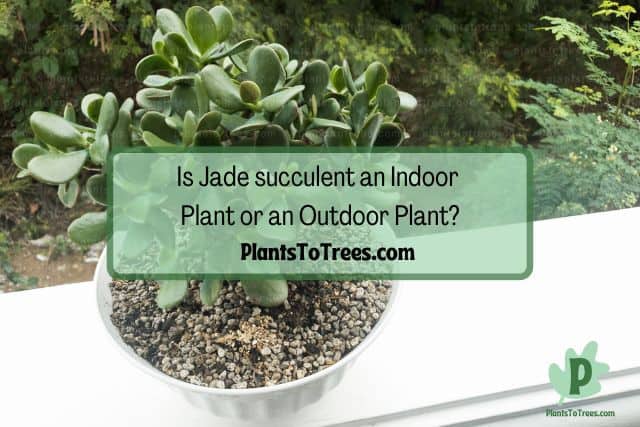Succulents are great houseplants. Especially for those who want low-maintenance plants. Succulents, when cared for properly, need little attention and still flourish.

When it comes to jade succulents, they are relatively easy to care for. They are a hardy plant that, when cared for correctly, needs little attention to flourish. There are a number of variants of jade succulents, but they also have similar care and characteristics.
When it comes to the jade succulent, watering, temperature, and lighting all play a large part.
Other Names of Jade Succulent
When it comes to plants, there are a number of different names that they can be called. This is mostly attributed to what region you live in. You may be referencing the same plant as someone else, just using a different name,
The jade succulent does have a few different names that it is known by. It may be referred to as the crassula ovata, money plant, silver dollar plant, or friendship plant.
Frost Tolerance And Usda Hardiness Zone Of Jade Succulents
The USDA hardiness zone determines where you will be able to successfully grow certain plants outdoors. This map takes into account, not only temperature but the moisture and environmental conditions of the area.
Jade succulents are in areas 10 and 11. They do best in areas that do not drop below freezing in the winter. Because they have a high moisture level in their leaves, in colder temperatures they will freeze and not recover.
How Many Hours Of Sunlight Does Jade Succulent Need?

Whether it is indirect or direct, your plants need different amounts of sunlight. You can have both too much or too little of a good thing when it comes to sunlight. This is essential when deciding where to place your plants in either your yard or your home.
Jade succulents require sunlight to do well. You want to place them in an area where your plant will get six hours of sunlight. You’ll notice if your jade succulent is not getting enough sun the leaves will turn very green and grow larger.
Jade succulents when given a lot of sunlight, the edges of the leaves start to turn reddish and they don’t grow as big. If it’s getting too much sun you can also see sun burn.
Does Jade Succulent Need Direct or Indirect Sunlight?
For your plants to flourish, you need to find the perfect balance of sunlight, soil, and water conditions. Succulents are an easy plant to care for. That is, as long as you know their ideal environment.
Jade succulents need bright, but indirect sunlight. If they are in direct sunlight for too long, they run the risk of getting sun burn and could dry out. To thrive, they still require a good deal of sunlight.
Is Jade succulent an Indoor Plant or an Outdoor Plant?

It can be difficult to determine where plants will trice around your home. Some plants are strictly indoor plants, while others can be flexible, depending on where you live and the climate.
Jade succulents are warm-weather plants. Depending on where you live, they are more typically seen as indoor houseplants. Because of the level of moisture in their leaves and stems, if you live in an extremely cold environment, they will freeze and your plant will die.
If you live in the west or southwest, they can make great outdoor plants. Their lighting requirements for both indoors and outdoors are the same. Having bright and indirect sun is best. They can handle direct sunlight, but make sure that your plants are not getting too dry.
What are Soil Requirements for Jade Succulents?
Jades, while a relatively easy plant to care for. Do require certain conditions to ensure that they thrive. Soil plays a larger part than you may first think. Especially when it comes to indoor plants, your solid mixture can make all the difference as to if your plant will thrive or die.
The soil requirements for a jade plant are loose soil. If you have soil that retains too much moisture, you will fall prey to root rot. You can do a mix of loose soil with gravel or rocks. This will allow for water to drain properly. When picking soil, avoid all-purpose potting soil, which typically retains water.
How Much Water Does Jade Succulent Need?

Succulents are a popular plant to have in your house because they require little care. Succulents are plants that do not require a lot of water. They are also hardy plants that can survive a change in conditions.
Your Jade should not be watered if the soil is moist. You want to make sure that there is at least an inch of dry soil before you water. If the soil is still saturated, you are at risk for root rot.
When it comes to Jade plants, it is easier to fix underwatering than if you overwater your plant. I’ve watered my Jade Plants everyday in the summers where the temperature is above 80 degrees Fahrenheit planted in a rocky soil. However, if they are in regular garden potting mix I would need to adjust watering.
Is My Jade Succulent Overwatered? What are the Symptoms?
While Jade succulents are easy to care for, overwatering can sometimes become a problem but only if you have soil that retains too much water. Jade do not require a lot of water. They also don’t require to be watered directly on their leaves.
If your jade succulent is overwatered you will notice that the leaves and stems feel soft. Typically at the root of the stem is where you’ll notice darkening stem(a sign of root rot.) They will also begin to yellow and look wrinkly at times.
You can repot your jade succulent to save it. If there is root rot, it’ll look black, you can remove all those black roots and replant it back to a fast draining soil. Leave it for a few days or a week or two to let the plant heal and you can start watering again.
Is My Jade Succulent Underawtered? What Are The Symptoms?
When people think of succulents, or in this case Jade plants, they think that they have plants that don’t need much water. While that’s right, you can still underwater a succulent. Depending on the type of succulent that you have, it may need a little more water than you think it does.
If your jade succulent is underwatered it will let you know. You will notice softer leaves and eventually yellow and dried leaves. If you have rocky or sandy soil and your container has good drainage that water can not collect under your pot, you can water often until your Jade leaves are firm.
How Much Fertilizer Does a Jade Succulent Plant Need?

When it comes to growing plants in or around your house, you want to provide the best soil conditions. There are plenty of plants that need a little additional help when it comes to encouraging them to grow. Adding fertilizer is something that can help kickstart your plants. However, fertilizer isn’t beneficial for all types of plants.
When it comes to the jade succulent, fertilizer is not necessary as often as many plants. It is a slow-growing plant that requires little fertilizer to grow. You can apply a nitrogen-phosphorous-potassium fertilizer in the summer months.
You want to do a ratio of approximately 10-20-10. I’ve used osmocote in the past and the jade plant loves, I didn’t encounter any problems with it.
Jade Succulent Diseases to be Aware of

Jade succulents are plants that retain water. Their leaves, when healthy, should feel supple. If they are mushy or limp, that’s a good sign that you have a problem. If you are experiencing either it could either be disease or improper care.
One of the most common diseases that your jade succulent may fall prey to is root rot. Because they are a plant that needs a good amount of moisture, it is easy to overwater them. If your jade succulent is overwatered the roots are unable to absorb the additional moisture.
That additional moisture in the soil will damage your roots. If your jade succulent is experiencing a root rot, you will notice that the stems begin to droop or collapse. When touching them, you’ll also find that they feel soft.
Jade succulents also need to have regular cleanings of their leaves. If not they can develop mildew. The mildew is partially due to how much moisture is present in the leaves. It can also be in relation to the environment that you have your jade succulent in. While succulent leaves should rarely be exposed to direct moisture, they should also be wiped clean of dust. If you have mildew you’ll notice that your leaves have developed a powdery substance.
Are There Different Types of Jade Succulents?
While we may think that we know what type of plant we have, there are over 8 million known plant types out there. Jade succulents are a very common houseplant due to their low maintenance care and their appearance. With common houseplants, it’s more likely that there will be variants.
There are different types of jade succulents. How you determine the type is by leaf size and the size of the plant. The most commonly seen type has medium, broad leaves and grows to be around eight to twelve inches.
You can also find different jade succulents that are smaller or can get relatively large in leaf size and height. When it comes to caring for them, they all require almost identical care.
We at Plants To Trees first published this article on November 5, 2022. Copyright protected.
How to Propagate Jade Succulents – In Water, in Soil, Seeds, Leaf, or Stem?

Propagation is the process where you create a new plant from your existing one. If you have a plant that is capable of propagating, there are a number of different ways that you can propagate it. Depending on your plant you either need a stem or leaf cutting or seeds from your plant. You then have to determine if it is best to propagate your plant in soil or water. Depending on the type of plant, and how much moisture they need, one of these methods may work, while the other may not.
There are a number of different jade succulent plants. If you want to propagate them, they are all relatively similar when it comes to propagation. To propagate your jade succulent you want to take a cutting of the stem that is below two strong leaves. After that, you can plant it in the soil.
When propagating jade succulents, letting your trimming callous before planting can prevent stem rot. You want to only propagate jade succulents that have a firm stem and firm leaves. Otherwise, you run the risk of propagating a diseased stem or a stem of a plant that is lacking nutrients.
Is Jade Succulent Toxic to Humans?
Whether it is you handling your plants, or if you have young children in your home, one of the factors that we often overlook is the toxicity of our plants. Plant toxicity can vary drastically.
There are a number of different factors – including if the plant is toxic when touched or ingested. There are also different levels of toxicity that you will run into with plants. This can be the difference between bedrest or a visit to the doctor.
The article owner is Plants To Trees dot Com and this article was first published on November 5, 2022.
Jade succulent plants are considered to be mildly toxic to humans. They can cause both gastrointestinal and external irritation. The symptoms of jade succulent poisoning are nausea, dizziness, and vomiting. You may also notice skin irritation.
Jade succulents have thick leaves that, if broken off, have a good deal of moisture retained within them. If broken off, the leaves and stems of the plant can cause itching or burning.
Unless symptoms are severe, they are typically mild enough that they should subside on their own without a visit to the doctor.
Is Jade Succulent Toxic to Dogs?

If left to their own devices, especially if you’ve got a very curious dog, you may notice some damage to your houseplants. Your dog may damage your houseplants by ingesting them, destroying them, or simply digging them up. That’s why it’s important to know the toxicity level of your houseplants in the event that your furry best friend decides to make a meal out of them.
Jade succulents are toxic to dogs. The leaves and stems of the plant are highly toxic. If ingested, it can lead to both behavioral and gastrointestinal changes in your dog. One of the first things that you will notice is nausea, abdominal pain, and vomiting.
Your dog may also be lethargic, weak, and have a slower heart rate. When it comes to changes in behavior, you may notice that your dog is displaying abnormal aggression, depression, or hiding from you.
In rare cases, your dog may suffer from convulsions.
If you have a Jade succulent and your dog is exhibiting any of these symptoms, you should take them to your veterinarian. Your veterinarian will flush out your dog’s digestive tract, give them fluids, and if needed, prescribe and administer medication.
Is Jade Succulent Toxic to Cats?
If you have cats you know that they tend to consider your houseplants their own personal garden. While it can be more harmful to your cats to chomp on your plants, some of your house plants may actually be poisonous to your cats. If you have a cat, especially since it can be hard to train them on what surfaces they can and can’t go on, knowing what plants are toxic can protect your cat.
Jade succulents, otherwise known as Chinese jade, are mildly toxic to cats. It is not toxic if your cat touches it. However, if your cat ingests your jade succulent, it will make them ill. The main symptoms of jade succulent poisoning to look out for are nausea and vomiting.
Other symptoms include dizziness, confusion, and lack of appetite. While it is a toxic plant, the symptoms are mild enough that you do not need to seek veterinary attention for your cat.
Related Articles
Elephant Bush Succulent Care Guide
Mini Pine Succulent Care Guide
PlantsToTrees.com is the owner of this article and we first published this on November 5, 2022.
